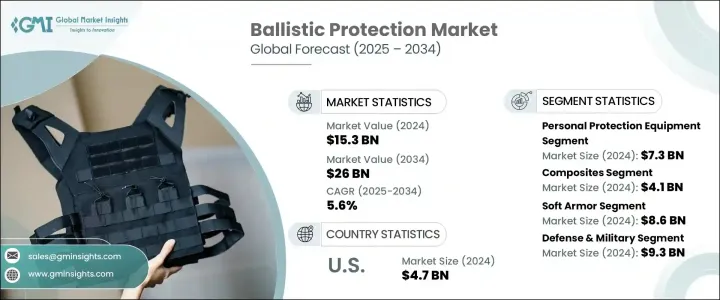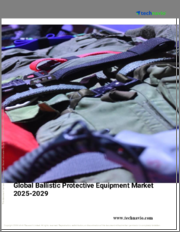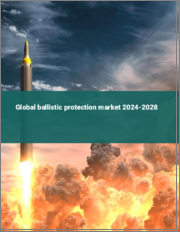
|
시장보고서
상품코드
1741017
탄도 보호 시장 : 시장 기회, 성장 촉진요인, 산업 동향 분석 및 예측(2025-2034년)Ballistic Protection Market Opportunity, Growth Drivers, Industry Trend Analysis, and Forecast 2025 - 2034 |
||||||
세계의 탄도 보호 시장은 2024년에는 153억 달러로 평가되었고, CAGR 5.6%로 성장할 전망이며, 2034년에는 260억 달러에 이를 것으로 예측됩니다.
이 일관된 성장은 세계 국방 지출 증가, 법 집행 기관 및 국토 안보 분야 수요 증가에 힘입어, 지정학적 긴장, 테러리즘, 시민 불안, 흉악 범죄 등의 위협 증대로 효과적인 보호 솔루션에 대한 투자에 위기감이 각국에서 높아지고 있습니다. 수요는 군사활동에 그치지 않고 정부, 공안기관, 심지어 리스크가 높은 지역의 일반시민까지도 선진적인 탄도 보호 기술을 적극적으로 요구하고 있습니다. 현재는 보다 가볍고 유연하며 적대적인 환경에서도 높은 효율을 발휘하는 적응성이 높은 소재가 채택되고 있습니다.

그러나 국제 무역 정책 등의 외적 요인이 제조업체에 큰 영향을 주고 있습니다. 특히 최근 미국 정권하에서 도입된 관세결정은 철강과 알루미늄 등의 필수 원재료에 고액의 관세를 부과함으로써 세계 공급망을 혼란시키고 있습니다. 이러한 관세는 헬멧, 방호복, 장갑차의 생산 비용을 상승시켜, 청부업자 및 제조업체에게 가격 설정의 재검토를 강요하거나, 생산 시설 이전 등, 보다 비용대비 효과가 높은 조달 전략을 모색하게 하고 있습니다. 더욱이, 이러한 경제적 장벽은 국경을 초월한 방위 협력을 긴장시켜, 공동 개발 프로젝트에 영향을 주거나 탄도 보호 장비품의 공급망에 불가결한 전략적 부품의 입수성을 저하시키고 있습니다.
| 시장 범위 | |
|---|---|
| 시작 연도 | 2024년 |
| 예측 연도 | 2025-2034년 |
| 시작 금액 | 153억 달러 |
| 예측 금액 | 260억 달러 |
| CAGR | 5.6% |
시장은 제품 유형별로 개인보호기기, 차량보호, 구조 및 고정 인프라로 구분됩니다. 이 중 개인보호구는 2024년 시장가치가 73억 달러로 이 카테고리를 이끌었습니다. 세계 무력 분쟁, 테러 활동, 안보 위협의 급증이 군인과 민간인 모두를 위해 설계된 보호구의 수요를 끌어올리고 있습니다. 경량 복합 재료, 고강도 세라믹, 고성능 폴리머 등 보다 고도의 재료에 대한 동향은 제품의 내구성 및 착용성을 향상시키고 있습니다. 이러한 변화는 치안상의 염려가 높아지고 있는 지역에서는 특히 현저하며, 법 집행 기관과 민간인 양쪽 모두가 점점 불안정해지는 환경에서 신뢰성 높은 방호를 요구하고 있기 때문입니다.
소재별로 보면 시장은 방탄유리, 복합재료, 세라믹, 금속 및 합금, 직물, 기타로 분류됩니다. 복합재료는 시장의 대부분을 차지하며 2024년 시장 규모는 41억 달러였습니다. 이러한 재료, 특히 섬유 강화 폴리머는 가벼우면서도 내구성이 우수하기 때문에 높은 수요가 있습니다. 그 용도는 개인용 보호구 및 장갑차 모두에서 현저합니다. 화학물질이나 극단적인 기후에 노출될 뿐만 아니라, 탄도 충격에도 견딜 수 있는 다기능 방호를 제공하는 재료에 대한 기호가 높아지고 있는 것이, 이 부문의 성장 가속에 기여하고 있습니다.
용도별로는 탄도 보호 산업은 방위 및 군사, 법집행 및 국토안전보장, 기타로 나눌 수 있습니다. 방위 및 군사 분야는 2024년 93억 달러의 수익을 올리는 압도적인 용도 분야입니다. 지역 분쟁의 격화나 시대에 뒤떨어진 군사 인프라를 업그레이드할 필요성 때문에 각국 정부는 최첨단 방호 기술에 고액의 투자를 실시하게 되어 있습니다. 각국은 방위 예산의 대부분을 할애해 위험도가 높은 지대에서 부대의 안전성을 높이는 고성능 장비품, 차량, 인프라 솔루션을 획득하고 있습니다.
미국은 2024년 평가액이 47억 달러에 달하고, 주요 시장으로 부상했습니다. 현재 진행 중인 국가안보상의 과제, 가정폭력 위협, 능동적인 총격 사건으로 인해 민군 양 부문에서 개인용 방어구 및 차량 보호에 대한 수요가 높아지고 있습니다. 이 나라 고액의 국방비는, 다양한 작전 조건하에서 고성능을 발휘하도록 설계된 차세대 탄도 솔루션의 채용을 한층 더 뒷받침하고 있습니다.
이 업계는 매우 세분화되어 있으며, 국제 기업과 지역 제조업체 모두가 존재하는 것이 특징입니다. 상위 3사는 총 20.4%의 시장 점유율을 차지하여 더 가볍고, 더 강하고, 더 스마트한 방호 시스템에 초점을 맞춘 선진 기술에 적극적으로 투자하고 있습니다. 여기에는 모듈식 장갑 플랫폼, 나노 재료 강화 패브릭, 실시간 위협 감지용 센서와 통합된 적응 가능한 장갑 시스템 등이 포함됩니다. 특히 세계 군사 전략이 도시작전, 비대칭전, 평화유지 임무로 전환됨에 따라 기민하고 임무에 맞게 맞춤형 방호로의 이행이 가속화되고 있습니다. 전술 차량, 항공기, 해군 시스템, 구급대원용 웨어러블 기어에서 탄도 솔루션 사용의 증가는 시장 진화의 다음 단계를 형성하고 있습니다.
목차
제1장 조사 방법 및 범위
제2장 주요 요약
제3장 업계 인사이트
- 생태계 분석
- 트럼프 정권의 관세에 대한 영향
- 무역에 미치는 영향
- 무역량의 혼란
- 보복 조치
- 업계에 미치는 영향
- 공급측의 영향
- 주요 부품의 가격 변동
- 공급망 재구성
- 생산 비용에 미치는 영향
- 수요측의 영향(판매가격)
- 최종 시장에 대한 가격 전달
- 시장 점유율 동향
- 소비자의 반응 패턴
- 공급측의 영향
- 영향을 받는 주요 기업
- 전략적인 업계 대응
- 공급망 재구성
- 가격 설정 및 제품 전략
- 정책관여
- 전망 및 향후 검토 사항
- 무역에 미치는 영향
- 업계에 미치는 영향요인
- 성장 촉진요인
- 세계 방위 예산 증가
- 지정학적 분쟁 및 테러리즘의 격화
- 법 집행 기관 및 국토 안보로부터의 요구
- 민간인 및 VIP의 보안 요구 증가
- 경량 소재의 기술 혁신
- 업계의 잠재적 위험 및 과제
- 첨단 재료의 고비용
- 복잡하고 다양한 규제 기준
- 성장 촉진요인
- 성장 가능성 분석
- 규제 상황
- 기술 상황
- 장래 시장 동향
- Porter's Five Forces 분석
- PESTEL 분석
제4장 경쟁 구도
- 서문
- 기업의 시장 점유율 분석
- 주요 시장 기업의 경쟁 분석
- 경쟁 포지셔닝 매트릭스
- 전략 대시보드
제5장 시장 추계 및 예측 : 제품 유형별(2021-2034년)
- 주요 동향
- 개인 보호구
- 차량 보호 장치
- 구조 및 고정 인프라
제6장 시장 추계 및 예측 : 재질별(2021-2034년)
- 주요 동향
- 방탄 유리
- 복합재료
- 세라믹
- 금속 및 합금
- 패브릭
- 기타
제7장 시장 추계 및 예측 : 기술별(2021-2034년)
- 주요 동향
- 소프트 아머
- 하드아머
제8장 시장 추계 및 예측 : 용도별(2021-2034년)
- 주요 동향
- 방위 및 군사
- 법 집행 기관 및 국토 안보
- 기타
제9장 시장 추계 및 예측 : 지역별(2021-2034년)
- 주요 동향
- 북미
- 미국
- 캐나다
- 유럽
- 독일
- 영국
- 프랑스
- 스페인
- 이탈리아
- 네덜란드
- 아시아태평양
- 중국
- 인도
- 일본
- 호주
- 한국
- 라틴아메리카
- 브라질
- 멕시코
- 아르헨티나
- 중동 및 아프리카
- 사우디아라비아
- 남아프리카
- 아랍에미리트(UAE)
제10장 기업 프로파일
- ADA
- ArmorSource
- ArmorWorks
- Avon Technologies
- BAE Systems
- Craig International Ballistics
- Elmon
- FMS Enterprises Migun
- Koninklijke Ten Cate
- MKU
- NP Aerospace
- Pacific Safety Products
- Paul Boye Technologies
- Point Blank Enterprises
- Revision Military
- Rheinmetall
- Roketsan
- Seyntex
- Southern States
- Survitec Group
The Global Ballistic Protection Market was valued at USD 15.3 billion in 2024 and is estimated to grow at a CAGR of 5.6% to reach USD 26 billion by 2034. This consistent growth is fueled by an uptick in defense spending worldwide and rising demands from law enforcement and homeland security sectors. Increasing threats such as geopolitical tensions, terrorism, civil unrest, and violent crime have created a heightened sense of urgency across countries to invest in effective protection solutions. The demand is not limited to military operations-governments, public safety bodies, and even civilians in high-risk areas are actively seeking advanced ballistic protection technologies. The market's upward momentum is also supported by the growing focus on innovation in protective equipment, which now includes more lightweight, flexible, and adaptable materials that offer higher efficiency in hostile environments.

However, external factors like international trade policies have significantly impacted manufacturers. In particular, tariff decisions introduced under recent U.S. administrations have disrupted global supply chains by imposing high duties on essential raw materials such as steel and aluminum. These levies have driven up production costs for helmets, body armor, and armored vehicles, forcing contractors and manufacturers to reevaluate their pricing structures or explore more cost-effective sourcing strategies, including relocating production facilities. Moreover, these economic barriers have strained cross-border defense collaborations, affecting joint development projects and reducing the accessibility of strategic components critical to the supply chain of ballistic protection equipment.
| Market Scope | |
|---|---|
| Start Year | 2024 |
| Forecast Year | 2025-2034 |
| Start Value | $15.3 Billion |
| Forecast Value | $26 Billion |
| CAGR | 5.6% |
The market is segmented by product type into personal protection equipment, vehicle protection, and structural and fixed infrastructure. Among these, personal protection equipment led the category with a market value of USD 7.3 billion in 2024. The surge in armed conflicts, terrorist activities, and security threats globally is pushing demand for protective gear designed for both military personnel and civilians. The trend toward more advanced materials like lightweight composites, high-strength ceramics, and high-performance polymers is improving product durability and wearability. This shift is especially relevant in regions facing elevated public safety concerns, as both law enforcement agencies and civilians seek reliable protection in increasingly unstable environments.
Material-wise, the market is categorized into bulletproof glass, composites, ceramics, metals and alloys, fabrics, and others. Composites held a significant portion of the market, valued at USD 4.1 billion in 2024. These materials, especially fiber-reinforced polymers, are in high demand due to their lightweight yet highly durable nature. Their application is prominent across both personal protective gear and armored vehicles. The increasing preference for materials that offer multifunctional protection-capable of resisting ballistic impact as well as exposure to chemicals and extreme climates-is contributing to the accelerated growth of this segment.
In terms of application, the ballistic protection industry is divided into defense and military, law enforcement and homeland security, and others. The defense and military sector stood as the dominant application area, generating USD 9.3 billion in revenue in 2024. Escalating regional conflicts and the need to upgrade outdated military infrastructure are pushing governments to invest heavily in state-of-the-art protective technologies. Countries are allocating significant portions of their defense budgets to acquire high-performance gear, vehicles, and infrastructure solutions that enhance troop safety in high-risk zones.
The United States emerged as the leading market, with a valuation of USD 4.7 billion in 2024. Ongoing national security challenges, domestic violence threats, and active shooter incidents have amplified the demand for personal armor and vehicle protection in both military and civilian sectors. The country's substantial defense expenditure has further propelled the adoption of next-generation ballistic solutions designed to deliver high-performance results in diverse operational conditions.
The industry is highly fragmented, marked by the presence of both international corporations and regional manufacturers. The top three companies, accounting for a collective 20.4% market share, are aggressively investing in advanced technologies that focus on lighter, stronger, and smarter protection systems. These include modular armor platforms, nanomaterial-enhanced fabrics, and adaptable armor systems integrated with sensors for real-time threat detection. The transition toward agile, mission-customizable protection is gaining pace, especially as global military strategies shift toward urban operations, asymmetric warfare, and peacekeeping missions. The increasing use of ballistic solutions in tactical vehicles, aircraft, naval systems, and wearable gear for first responders is shaping the next phase of the market's evolution.
Table of Contents
Chapter 1 Methodology and Scope
- 1.1 Market scope and definitions
- 1.2 Research design
- 1.2.1 Research approach
- 1.2.2 Data collection methods
- 1.3 Base estimates and calculations
- 1.3.1 Base year calculation
- 1.3.2 Key trends for market estimation
- 1.4 Forecast model
- 1.5 Primary research and validation
- 1.5.1 Primary sources
- 1.5.2 Data mining sources
Chapter 2 Executive Summary
- 2.1 Industry 3600 synopsis
Chapter 3 Industry Insights
- 3.1 Industry ecosystem analysis
- 3.2 Trump administration tariffs
- 3.2.1 Impact on trade
- 3.2.1.1 Trade volume disruptions
- 3.2.1.2 Retaliatory measures
- 3.2.2 Impact on the industry
- 3.2.2.1 Supply-side impact
- 3.2.2.1.1 Price volatility in key components
- 3.2.2.1.2 Supply chain restructuring
- 3.2.2.1.3 Production cost implications
- 3.2.2.2 Demand-side impact (selling price)
- 3.2.2.2.1 Price transmission to end markets
- 3.2.2.2.2 Market share dynamics
- 3.2.2.2.3 Consumer response patterns
- 3.2.2.1 Supply-side impact
- 3.2.3 Key companies impacted
- 3.2.4 Strategic industry responses
- 3.2.4.1 Supply chain reconfiguration
- 3.2.4.2 Pricing and product strategies
- 3.2.4.3 Policy engagement
- 3.2.5 Outlook and future considerations
- 3.2.1 Impact on trade
- 3.3 Industry impact forces
- 3.3.1 Growth drivers
- 3.3.1.1 Increasing global defense budgets
- 3.3.1.2 Rising geopolitical conflicts and terrorism
- 3.3.1.3 Demand from law enforcement and homeland security
- 3.3.1.4 Growing civilian and VIP security needs
- 3.3.1.5 Technological innovations in lightweight materials
- 3.3.2 Industry pitfalls and challenges
- 3.3.2.1 High costs of advanced materials
- 3.3.2.2 Complex and varying regulatory standards
- 3.3.1 Growth drivers
- 3.4 Growth potential analysis
- 3.5 Regulatory landscape
- 3.6 Technology landscape
- 3.7 Future market trends
- 3.8 Porter's analysis
- 3.9 PESTEL analysis
Chapter 4 Competitive Landscape, 2024
- 4.1 Introduction
- 4.2 Company market share analysis
- 4.3 Competitive analysis of major market players
- 4.4 Competitive positioning matrix
- 4.5 Strategy dashboard
Chapter 5 Market Estimates and Forecast, By Product Type, 2021 - 2034 (USD Million & Million Units)
- 5.1 Key trends
- 5.2 Personal protection equipment
- 5.3 Vehicle protection equipment
- 5.4 Structural & fixed infrastructure
Chapter 6 Market Estimates and Forecast, By Material Type, 2021 - 2034 (USD Million & Million Units)
- 6.1 Key trends
- 6.2 Bulletproof glass
- 6.3 Composites
- 6.4 Ceramics
- 6.5 Metal & alloys
- 6.6 Fabric
- 6.7 Others
Chapter 7 Market Estimates and Forecast, By Technology, 2021 - 2034 (USD Million & Million Units)
- 7.1 Key trends
- 7.2 Soft armor
- 7.3 Hard armor
Chapter 8 Market Estimates and Forecast, By Application, 2021 - 2034 (USD Million & Million Units)
- 8.1 Key trends
- 8.2 Defense & military
- 8.3 Law enforcement & homeland security
- 8.4 Others
Chapter 9 Market Estimates and Forecast, By Region, 2021 - 2034 (USD Million & Million Units)
- 9.1 Key trends
- 9.2 North America
- 9.2.1 U.S.
- 9.2.2 Canada
- 9.3 Europe
- 9.3.1 Germany
- 9.3.2 UK
- 9.3.3 France
- 9.3.4 Spain
- 9.3.5 Italy
- 9.3.6 Netherlands
- 9.4 Asia Pacific
- 9.4.1 China
- 9.4.2 India
- 9.4.3 Japan
- 9.4.4 Australia
- 9.4.5 South Korea
- 9.5 Latin America
- 9.5.1 Brazil
- 9.5.2 Mexico
- 9.5.3 Argentina
- 9.6 Middle East and Africa
- 9.6.1 Saudi Arabia
- 9.6.2 South Africa
- 9.6.3 UAE
Chapter 10 Company Profiles
- 10.1 ADA
- 10.2 ArmorSource
- 10.3 ArmorWorks
- 10.4 Avon Technologies
- 10.5 BAE Systems
- 10.6 Craig International Ballistics
- 10.7 Elmon
- 10.8 FMS Enterprises Migun
- 10.9 Koninklijke Ten Cate
- 10.10 MKU
- 10.11 NP Aerospace
- 10.12 Pacific Safety Products
- 10.13 Paul Boye Technologies
- 10.14 Point Blank Enterprises
- 10.15 Revision Military
- 10.16 Rheinmetall
- 10.17 Roketsan
- 10.18 Seyntex
- 10.19 Southern States
- 10.20 Survitec Group

















